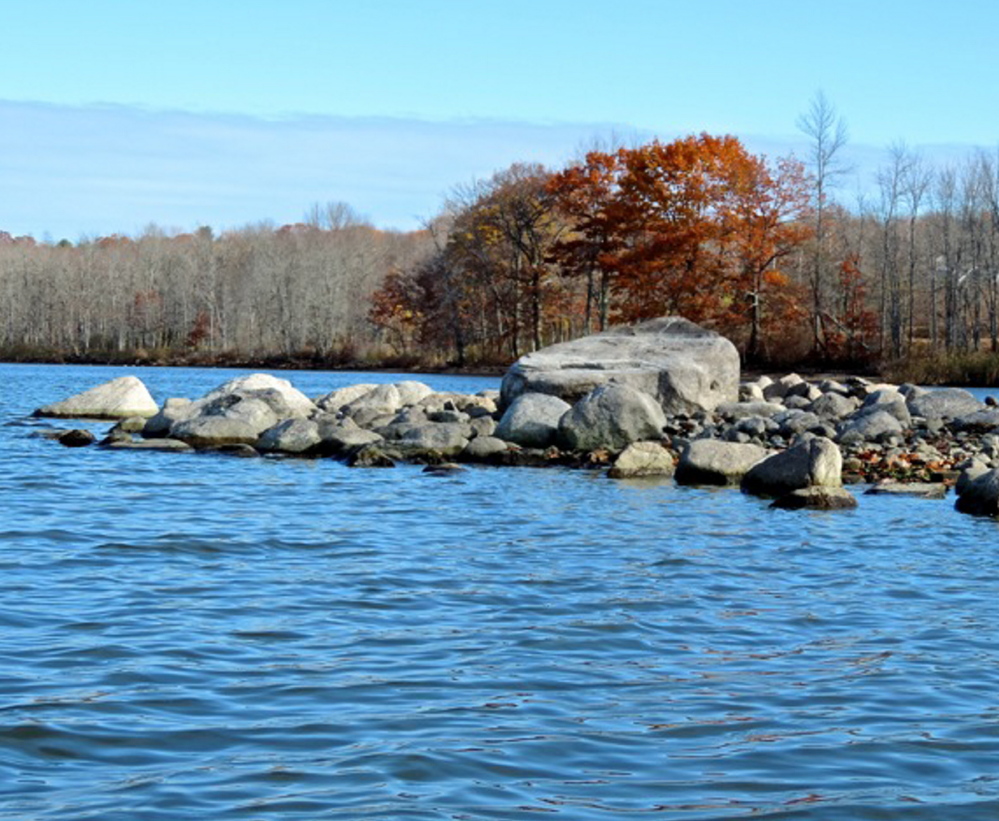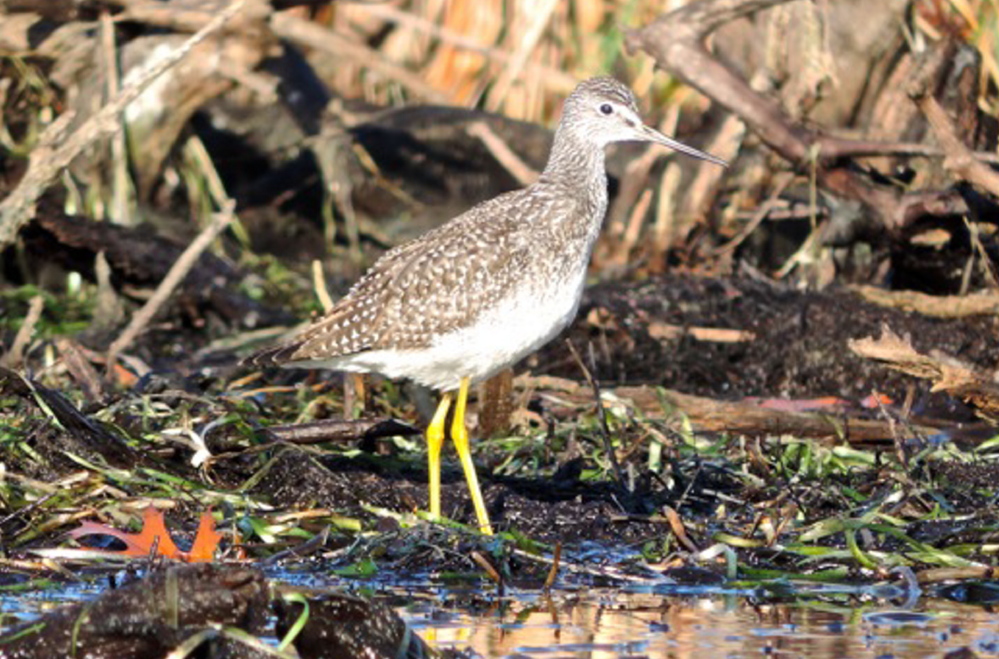November has become one of our favorite months to explore local waterways by canoe. No people, no bugs, and still enough dazzling foliage and migrating waterfowl to keep us busy with the binoculars. Granted, you have to keep a close eye on the weather forecast this time of year and be a little flexible with your schedule. There is a calm, warm, sunny day out there waiting just for you. One of the best spots to enjoy great scenery and lots of birdlife is the northern portion of Sabattus Pond. We call it the “Scarborough Marsh” of central Maine – the birding is that good. The northern end of the pond contains plenty of grasses and shallow waters to meet the caloric needs of thousands of birds. And thousands we saw.
Consult the Delorme Maine Atlas and Gazetteer (Map 12) for help in getting to the put-in spot at Thompson Bridge on Bull Run Road 1.4 miles west of Route 132 in Wales. There is enough room on either side of the bridge to pull off the road and park. It is a short carry down to the channel that leads south into the pond. Wear your Bean boots – the water levels are low right now and the put-in spot is muddy. From the bridge, we could already hear the honking of geese filtering through the trees from the open water.
We enjoyed three hours of exploring. This four-mile long pond, eight miles east of Lewiston, is lined with many cottages along the shoreline so we stayed in the less developed northern cove and paddled along the northeastern shoreline where all the birds are. We saw a flock of at least 100 mallards lift up into the air. It was as if they were trying in unison to pull the covering off the earth as they powerfully and purposely strained skyward.
Left in their wake were flocks of American coots with their distinctive white beaks and dark bodies. Although not technically ducks, they like to hang with the mallards in the shallows, feeding on all the morsels the mallards stir up with their webbed fee.
We circled around a low grassy island and spotted a black-bellied plover foraging along a narrow sandbar at water’s edge. What a surprise. These birds are the largest plovers in our hemisphere and breed up in the high Arctic during the summer.
Greater yellowlegs caught our attention along the near shore. A flock of red-breasted mergansers circled over the open water.
The pond is surrounded by low hills and undulating ridges, still carpeted with a vibrant tapestry of fall colors; browns of oaks, yellows of poplar and birch, greens of pine and fir. We even saw a few larch trees along the shoreline. Halfway down the eastern side of the pond towers conical Sabattus Mountain, rising 550 feet above the water.
Given all the fertile farmland in the area, there are hundreds of gulls on the pond. Murmurations of starlings danced through and over the northern marsh, often landing in the trees and power lines to the north for a rest. A kingfisher flew along the shoreline on our right. A pair of wood ducks splashed down 100 yards ahead of us. Two blue herons stood motionless on a muddy banking only yards away. We finally decided to divide up the responsibilities, with my wife doing the roll call of critters on the right and me taking care of identification to the left.
As we started to head back up the channel toward the put-in we noticed a small stream off to the right. The stream is shallow with lots of twists and turns, but don’t pass it up. You will see lots of birds here, too. Can you make it all the way up to Bull Run Road?
Back at the bridge we paddled a few hundred yards upstream, but given the low water of the annual winter drawdown we decided to come back in the late spring when the water will be at its highest level. That will give us more water to explore a few miles north up both Hooper Brook and the Dead River. What migrants will we see then?
We are very much amateur birders and had been told by friends we might also see this time of year lesser scaup, green-winged teal, hooded mergansers and ring-necked ducks on our visit to Sabattus Pond. Maybe they were mixed in with all the other flocks of birds we saw, maybe not. You will probably see them on your visit.
Michael Perry is the former director of the L.L. Bean Outdoor Discovery Schools, and founder of Dreams Unlimited, specializing in inspiring outdoor slide programs for civic groups, businesses, and schools.
Contact: michaelj_perry@comcast.net
Copy the Story LinkSend questions/comments to the editors.




Success. Please wait for the page to reload. If the page does not reload within 5 seconds, please refresh the page.
Enter your email and password to access comments.
Hi, to comment on stories you must . This profile is in addition to your subscription and website login.
Already have a commenting profile? .
Invalid username/password.
Please check your email to confirm and complete your registration.
Only subscribers are eligible to post comments. Please subscribe or login first for digital access. Here’s why.
Use the form below to reset your password. When you've submitted your account email, we will send an email with a reset code.